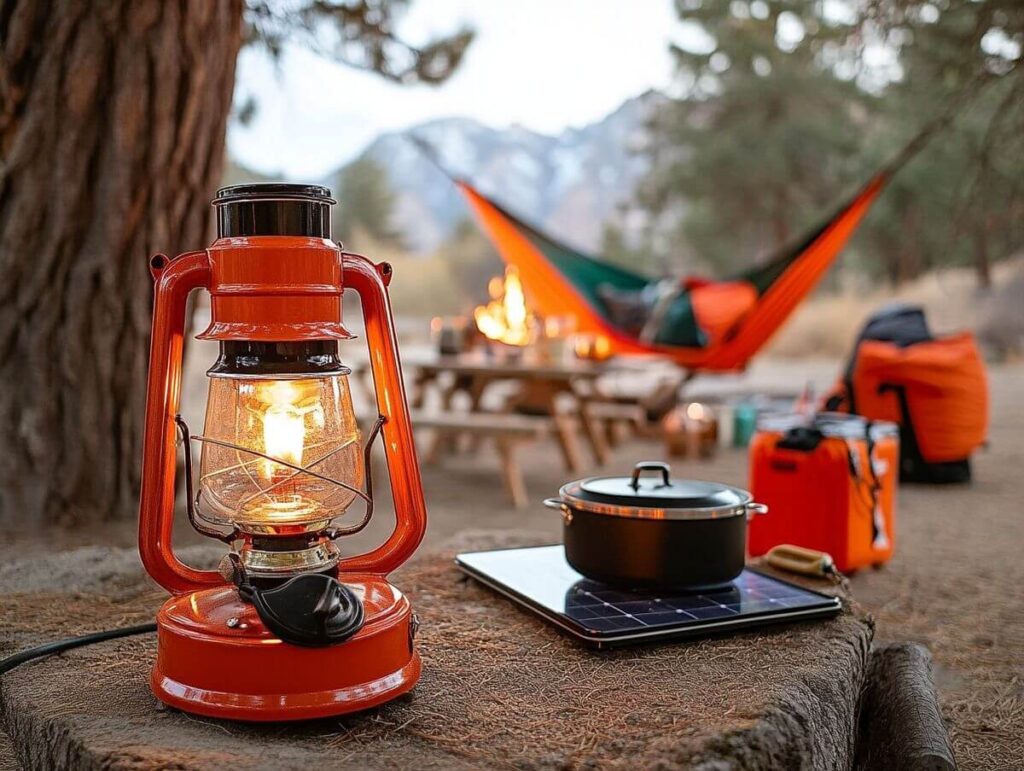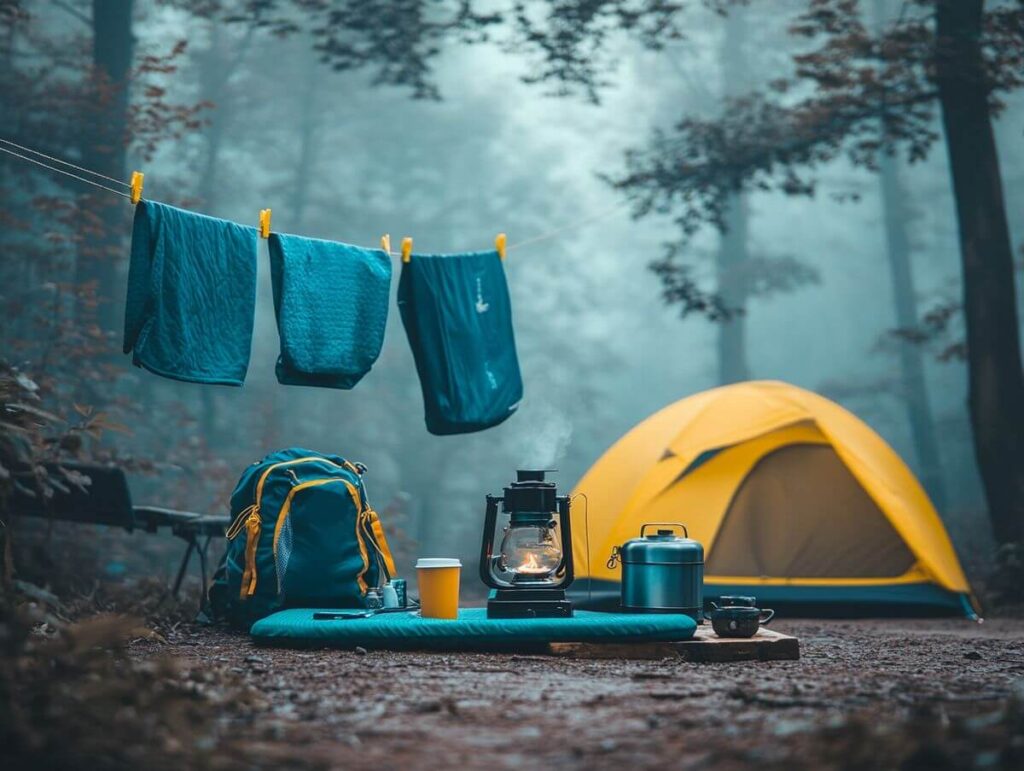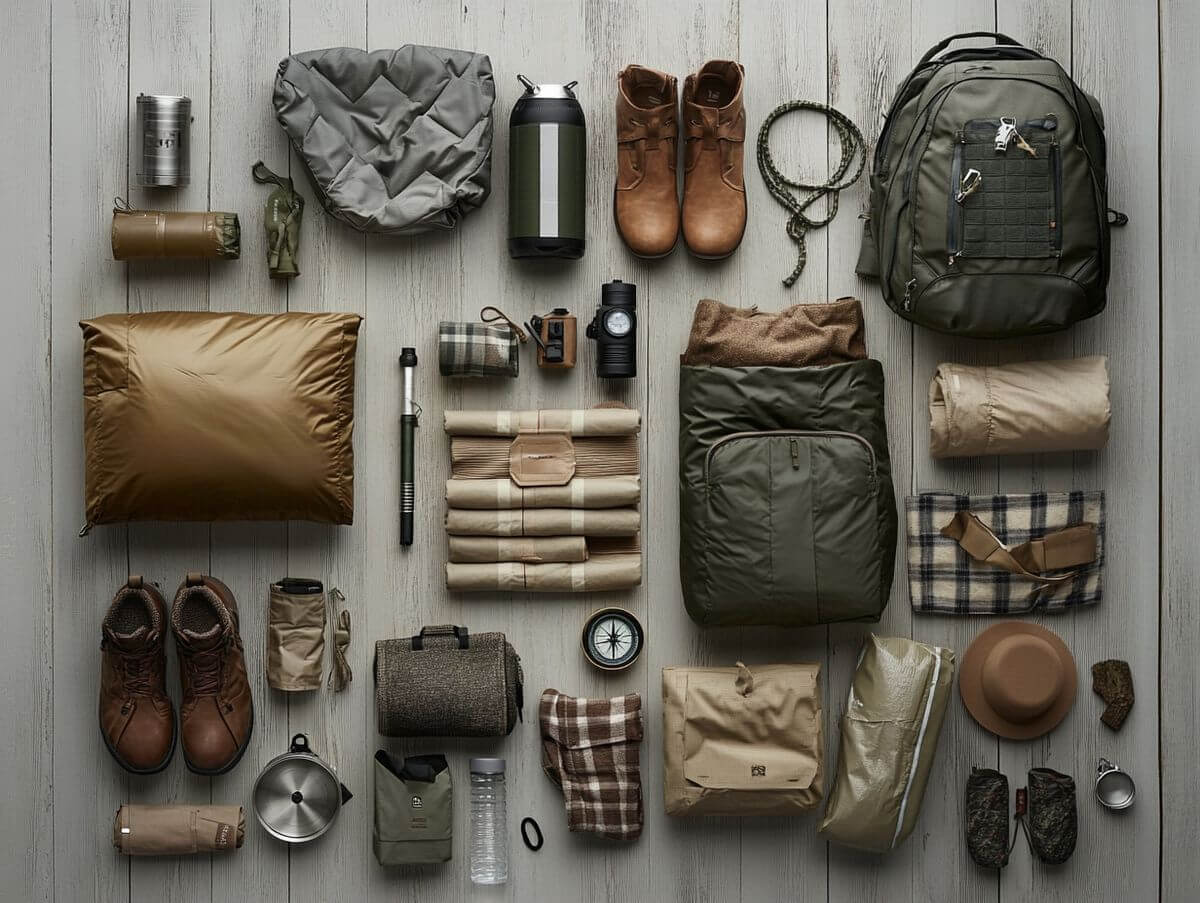Ready to spend some quality time in the great outdoors? This essential camping gear checklist will help make sure you don’t leave anything at home.
No matter what kind of camper you are, this checklist will serve as a great starting point for planning your next trip.
Essential Camping Checklist
This camping checklist is meant to cover a wide range of different camping styles. However, if you’re someone who prefers a more traditional/minimal camping style, you’ll probably disregard some of the items on this list.
As long as you have items to address your most important needs (water, food, shelter, warmth), feel free to experiment and find the right setup for you.
1. Shelter & Sleeping
☐ Tent & extra stakes
☐ Sleeping bag & liner
☐ Camping mat/sleeping pad
☐ Camping pillow
☐ Camping blanket
☐ Hammock
☐ Sunshade/awning (setup dependent)
2. Lights & Power
☐ Headlamp with batteries/charger
☐ Lantern
☐ Extra batteries
☐ Power bank (with solar panel if applicable)
3. Camp Furniture & Setup Gear
☐ Camping chairs
☐ Portable camping table
☐ Tablecloth
☐ Hammer (for stakes)
☐ Paracord
☐ Dry bags or storage bins
☐ Multi-tool
☐ Duct tape
4. Cooking
☐ Camp stove & fuel
☐ Cookware (pots, pans)
☐ Cooking utensils
☐ Eating utensils
☐ Plates/bowls
☐ Cups/mugs
☐ Portable cutting board
☐ Can opener/bottle opener
☐ Cooking knife
☐ Portable coffee or tea maker
☐ Cooler
☐ Water jugs
☐ Camping sink for gray water
5. Clothes
☐ Baselayer/long underwear
☐ Moisture-wicking underwear & T-shirts
☐ Hiking pants/shorts
☐ Down/synthetic down jacket
☐ Rain jacket
☐ Fleece jacket
☐ Hiking shoes/boots
☐ Sandals/slippers
☐ Hiking socks
☐ Gloves
☐ Warm hat
☐ Sun hat
☐ Sunglasses
☐ Sleepwear
☐ Swimsuit
6. Campfire Tools
☐ Firewood (if needed)
☐ Axe/hatchet
☐ Portable saw
☐ Fire starter
☐ Matches/lighter
7. Hygiene
☐ Toiletries (toothbrush, toothpaste, etc.)
☐ Quick-dry towel
☐ Toilet paper
☐ Baby wipes
☐ Hand sanitizer
☐ Camping toilet
☐ Solar/camping shower
☐ Menstrual/urinary products
8. Safety & Navigation
☐ First-aid kit
☐ Water filtration
☐ Bear spray
☐ Compass & map
☐ Binoculars
☐ Forest Service/park pass
☐ Campsite reservation
☐ Relevant field guides
☐ Prescription medications
9. Sun & Bug Protection
☐ Sunscreen
☐ Chapstick
☐ Bug repellent
10. Campsite Entertainment
☐ Star chart/night-sky identifier (there are apps for this on your phone)
☐ Books/e-books
☐ Notepad & pencil or pen
☐ Headphones
☐ Laptop/media player (for rainy days)
☐ Camping games
11. Pet-Related Essentials
☐ Leash and collar with ID tags
☐ Pet first aid supplies
☐ Water bowl
☐ Pet food in sealed container (important so you don’t attract wildlife)
☐ Poop bags
☐ Bed or sleeping pad
☐ Any medications
12. Cleaning & Trash
☐ Biodegradable soap
☐ Dish towel
☐ Sponges
☐ Trash bags
☐ Small broom and dustpan
How to Use This Checklist
You likely won’t need every single item for every trip it all depends on your specific plans. However, this camping checklist will serve as a great starting point to make sure you don’t forget anything crucial. Save it on your phone or print it out to reference as you pack.

Understanding Your Camping Style
Car Camping: When you can park right next to your campsite, you’ve got the luxury of bringing those comfort items that make camping feel a bit more like home. Load up your chairs, bring the bigger cooler, and don’t worry too much about weight your car’s doing all the heavy lifting.
Backpacking: When everything goes on your back, every ounce matters. You’ll want to focus on lightweight, multi-purpose gear and skip the luxury items. Look for compact versions of the essentials and be strategic about what you really need.
Glamping: If you’re headed to a furnished glamping site, you’re in luck many of these items will already be waiting for you. Check with your host about what’s included, then use this list to fill in any gaps and add your personal touches.
RV/Travel Trailer: Your home on wheels probably already has many of these items stored away. Focus on checking your stock of consumables (food, propane, water), making sure all your systems are good to go, and keeping your essential supplies topped up. We recommend making an entirely separate checklist for RV-specific items and systems.
Seasonal Adjustments to The Checklist
- Spring: You’ll want extra rain gear and warm layers spring weather likes to keep you guessing. And don’t forget gear for muddy conditions!
- Summer: Focus on sun protection and staying cool. Pack extra water you’ll be glad you did.
- Fall: Layer up and pack weather-resistant gear. The days are getting shorter, so good lighting is key.
- Winter: Double down on warmth with extra sleeping bags and thermal layers. Winter camping requires serious weather prep.
First-Time Camper Notes
If you’re not an experienced camper, you’ll want to go a bit further than simply bringing items from this checklist. Here’s what we recommend doing…

Setting Up Your Gear at Home
Don’t wait until you’re at your campsite to figure out how your tent works. Set it up in your backyard or living room first. You’ll want to make sure you have all the pieces and know how everything fits together. Practice setting it up and taking it down a couple of times. You’ll thank yourself later when you’re doing it in fading daylight or less-than-perfect weather.
Mastering Your Camp Stove
Your camp stove is going to be your best friend for hot meals and that essential morning coffee. Before you head out, get comfortable with how it works. Practice connecting the fuel, get a feel for the controls, and even try cooking a simple meal on it. It’s different from your kitchen stove, so you’ll want to know its quirks. Don’t forget to test any fuel lanterns or heaters you’re bringing along too.
Weather Research and Preparation
Take some time to check out both the long-term and short-term forecasts for where you’re heading. Look at what the weather usually does in that area during your planned camping dates.
Keep in mind that temperatures can swing wildly between day and night, especially in places like mountains. Pack clothes and gear that’ll keep you comfortable in conditions about 10-20 degrees warmer and colder than what’s predicted.
Understanding Campsite Rules
Every campsite has its own rules, so take a few minutes to look them up before you go. You’ll want to know about quiet hours, if campfires are allowed, and if there’s wildlife you need to account for (by sealing up food). And if you’re bringing your four-legged friend, make sure to check the pet policies.
Sharing Your Plans
Always let someone reliable know where you’re headed. Give them the specifics: your exact camping spot if you know it, when you’re planning to arrive and leave, who’s going with you, and what vehicle you’re driving. Set up a check-in time and let them know when they should contact authorities if they haven’t heard from you. Make sure they have the rangers’ station number too. It might seem like overkill, but it’s one of those better-safe-than-sorry situations.
A Garmin inReach is a great tool for making this easy, even if you’re camping somewhere that doesn’t have cell service.
Timing Your Arrival
Try to get to your campsite well before sunset. This gives you some light to pick a good spot, set up without fumbling in the dark, and get organized.
Pack Extra Essentials
When it comes to camping basics, a little extra never hurt anyone (assuming you can carry it).
Throw in some spare batteries for everything that needs them. Pack food for one more day than you plan to stay. Bring more water than you think you’ll need, and always have a backup light source or two. And pack those extra layers weather can be unpredictable, and temperatures can swing more than you might expect.
Starting Simple
For your first time out, car camping at an established campground is the way to go. It gives you that perfect mix of outdoor adventure and convenience. Your car becomes a reliable backup for storage, and you’ll have basic amenities close by.
Most established campgrounds have staff around if you need help, and if things aren’t working out, you can easily head home. Plus, you’ll likely have cell service for those “how do I light this stove again?” moments.
Camping with Experienced Friends
If you can tag along with someone who knows their way around a campsite, do it. They’ll know the tips and tricks that only come from experience, can help you avoid rookie mistakes, and might even loan you some gear so you don’t have to buy everything at once. They can show you the ropes of setting up camp and teach you outdoor skills that would take way longer to figure out on your own.
Common Mistakes and Solutions
Knowing some common mistakes can help you avoid headaches later. Here are some of the main ones to keep in mind when working through this camping checklist.
Fire Dependence:
Always have a backup plan for cooking. Sometimes fires aren’t allowed, wood gets wet, or you’re just too tired to deal with it. A camp stove is your reliable friend, and they come in all shapes and sizes.
Clothing Choices:
Skip the cotton when it gets wet, it stays wet, and that can lead to a miserable (and potentially dangerous) situation. Go for synthetic or wool layers that dry quickly and keep you warm.
Lighting Issues:
Don’t skimp on light sources. Bring a headlamp, lantern, and flashlight. Then pack twice the batteries you think you’ll need. Moving around camp in the dark is no fun.
Gear Check:
Test everything before you leave home. Look for tears, missing pieces, or damage. Make sure you know how to use each piece of equipment.
Weather Preparedness:
Pack for what could happen, not just what’s forecast. Bring rain gear even if the forecast looks clear. Layer your clothing so you can adjust as conditions change (and they always do).
